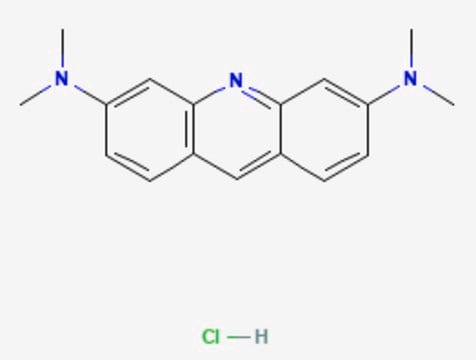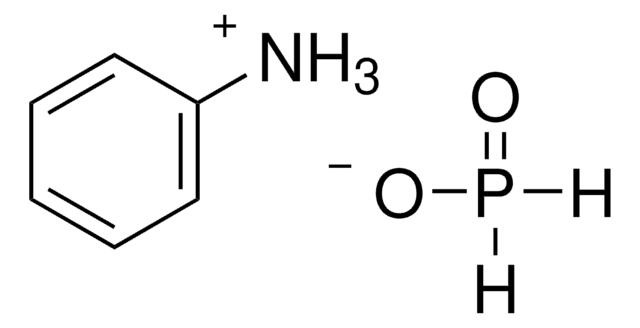214906
Hypophosphorous acid solution
50 wt. % in H2O
Sinónimos:
Phosphinic acid
About This Item
Productos recomendados
vapor pressure
<17 mmHg ( 20 °C)
Quality Level
form
liquid
concentration
48-52% in NaOH (titration)
50 wt. % in H2O
pH
1 (20 °C, 500 g/L)
density
1.206 g/mL at 25 °C
SMILES string
O[PH2]=O
InChI
1S/H3O2P/c1-3-2/h3H2,(H,1,2)
InChI key
ACVYVLVWPXVTIT-UHFFFAOYSA-N
¿Está buscando productos similares? Visita Guía de comparación de productos
Categorías relacionadas
General description
It undergoes oxidation in the presence of Ce(IV) and a strong acid to afford cerium(IV) hypophosphite complex ions.
Application
- Synthesis of Aminobisphosphinates through a Cascade Reaction between Hypophosphorous Acid and Bis(trimethylsilyl)imidates Mediated by ZnI(2).: This research presents a novel method for synthesizing aminobisphosphinates, utilizing hypophosphorous acid in a zinc iodide-mediated cascade reaction, which could be relevant in the development of new chemical entities in medicinal chemistry (Ayadi et al., 2023).
- Facile Synthesis of Liquid Crystal Dimers Bridged with a Phosphonic Group.: This study explores the use of hypophosphorous acid in the synthesis of phosphonic group-bridged liquid crystal dimers, offering potential advancements in materials science and display technologies (Wang et al., 2022).
- Oxidation of Hypophosphorous Acid by a Ruthenium(VI) Nitrido Complex in Aqueous Acidic Solution. Evidence for a Proton-Coupled N-Atom Transfer Mechanism.: Investigates the mechanistic details of hypophosphorous acid oxidation by a ruthenium complex, shedding light on reaction pathways important in catalysis and synthesis (Li et al., 2022).
- Solution-processed Ge(ii)-based chalcogenide thin films with tunable bandgaps for photovoltaics.: Discusses the application of hypophosphorous acid in the development of germanium-based chalcogenide thin films, contributing to advancements in photovoltaic materials (Hu et al., 2022).
- One-Pot Synthesis and in Silico Molecular Docking Studies of Arylselanyl Hydrazides as Potential Antituberculosis Agents.: Utilizes hypophosphorous acid in the one-pot synthesis of arylselanyl hydrazides, evaluated for their potential as antituberculosis agents through molecular docking studies (Borges et al., 2022).
signalword
Danger
hcodes
Hazard Classifications
Eye Dam. 1 - Met. Corr. 1 - Skin Corr. 1B
Storage Class
8B - Non-combustible corrosive hazardous materials
wgk_germany
WGK 1
flash_point_f
Not applicable
flash_point_c
Not applicable
Certificados de análisis (COA)
Busque Certificados de análisis (COA) introduciendo el número de lote del producto. Los números de lote se encuentran en la etiqueta del producto después de las palabras «Lot» o «Batch»
¿Ya tiene este producto?
Encuentre la documentación para los productos que ha comprado recientemente en la Biblioteca de documentos.
Los clientes también vieron
Nuestro equipo de científicos tiene experiencia en todas las áreas de investigación: Ciencias de la vida, Ciencia de los materiales, Síntesis química, Cromatografía, Analítica y muchas otras.
Póngase en contacto con el Servicio técnico















